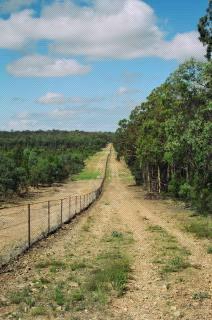Pest Managment - Darling Downs Moreton Rabbit Board
Darling Downs-Morton Rabbit Board Controlling pest such as rabbits within the rabbit proof fence.
About Us
The Darling Downs–Moreton Rabbit Board maintains 555 km of Rabbit–proof fence, which runs from Mt Gipps (near Rathdowney) to Goombi (between Chinchilla and Miles), where it joins up with the Wild Dog Barrier Fence. The land adjacent to the rabbit-proof fence is mainly private property. As such travel along the rabbit-proof fence is not permitted without prior authority from the Darling Downs-Moreton Rabbit Board and each individual landholder.

The Board’s role is to maintain the fence in rabbit–proof condition and to monitor compliance with the Biosecurity Act 2014. The Board provides technical and other advice to landholders in the Board operational area to assist with rabbit eradication. The Board area is made up of 8 local authorities, and covers approximately 28,000 square kilometres (7 million acres). The Board currently employs 15 staff and maintains 8 houses along the fence for the patrolmen and their families. Although most of the patrols are now done by motor vehicle or all terrain vehicles, some patrols must still be done on foot, due to the rugged nature of the terrain.
When the fence was first constructed in 1893, the cost to erect the fence was approximately $113.00 per mile. The last additional section of fence to be erected in 1997, north from Goombi to link with the Wild Dog Barrier Fence (approx. 24 kilometres) cost approximately $6500.00 per kilometre. This cost has increased significantly over the ensuing years. The most recent cost estimate for rabbit-proof fencing is approximately $ 18,000.00 to $ 20,000.00 per km or more, depending upon terrain and soil type.
In most cases the Rabbit-proof fence is 1220 mm high, and the foot-netting, where possible, is buried 200 mm into the ground.
In a number of areas the rabbit fence also acts as a wild-dog fence, with 184 km of the rabbit fence being top–netted to a height of 1800 mm. It has been estimated that Rabbits cost the Australian rural industry in excess of $ 600 million per year.
 A study undertaken by Mr. John Robertshaw in 1994 (Department of Natural Resources and Water (NR&W)) on the value of the Rabbit Board to the rural communities, came to the conclusion that the Darling Downs–Moreton Rabbit Board saved the 8 local authority areas within the Board area millions of dollars per year. These savings were achieved through better stocking rates, more wool production per head of sheep, less accidents due to absence of rabbit burrows, a more productive small crops industry and less land degradation.
A study undertaken by Mr. John Robertshaw in 1994 (Department of Natural Resources and Water (NR&W)) on the value of the Rabbit Board to the rural communities, came to the conclusion that the Darling Downs–Moreton Rabbit Board saved the 8 local authority areas within the Board area millions of dollars per year. These savings were achieved through better stocking rates, more wool production per head of sheep, less accidents due to absence of rabbit burrows, a more productive small crops industry and less land degradation.
The 8 local authority areas protected by the Darling Downs–Moreton Rabbit Board pay an annual precept to the Dept of Agriculture and Fisheries (DAF) for this service. Land Protection Officers (from Biosecurity Queensland-DAF) assist landholders with rabbit control in regions that fall outside the Board operational area.
Methods to Eradicate Rabbits include the following:
Pindone poison
Fumigation of rabbit warrens
Shooting
Trapping
Ripping of warrens by tractor to a minimum depth of 600mm
Removal of above ground harbour e.g. timber piles, blackberry bushes, boxthorn, car bodies etc
Raising Shipping Containers at least 600mm above the ground
Biological controls e.g. Myxomatosis or Rabbit Calicivirus Disease
All these methods have their place in Rabbit control and are used according to the situation at hand.
Diseases of Rabbits include:
Myxomatosis
Rabbit Calicivirus
Hydatids
Coccidiosis
and Liver Fluke.
Rabbits are also affected by:
Intestinal worms
Dog tapeworms
and they can carry ticks, European Fleas, and Spanish Fleas.


